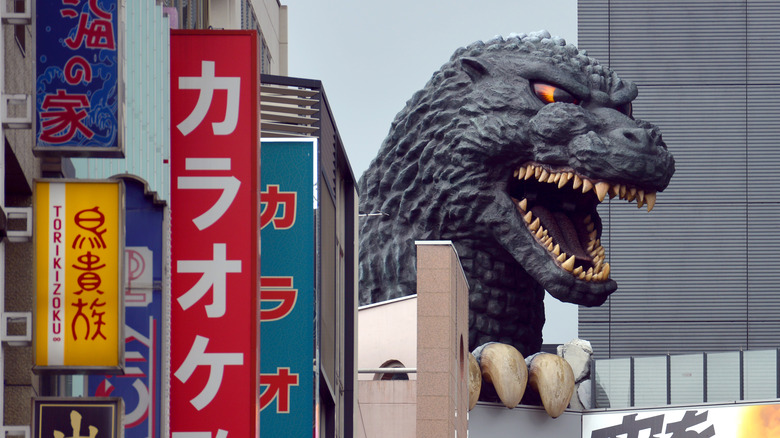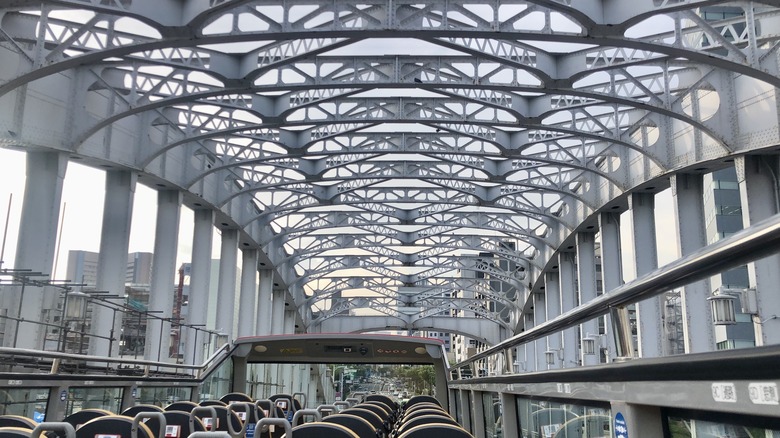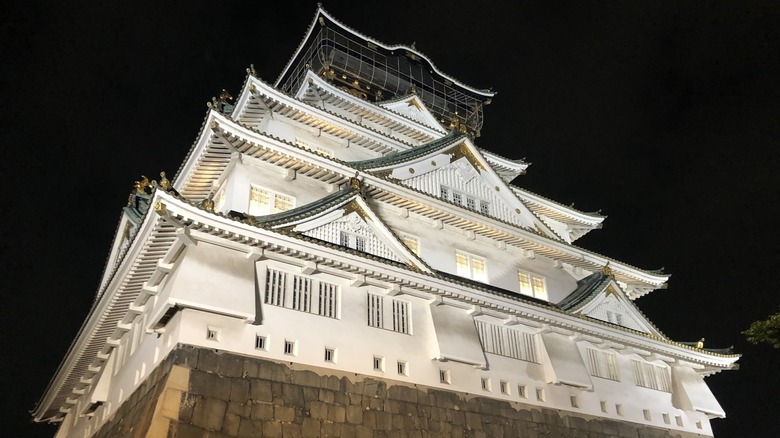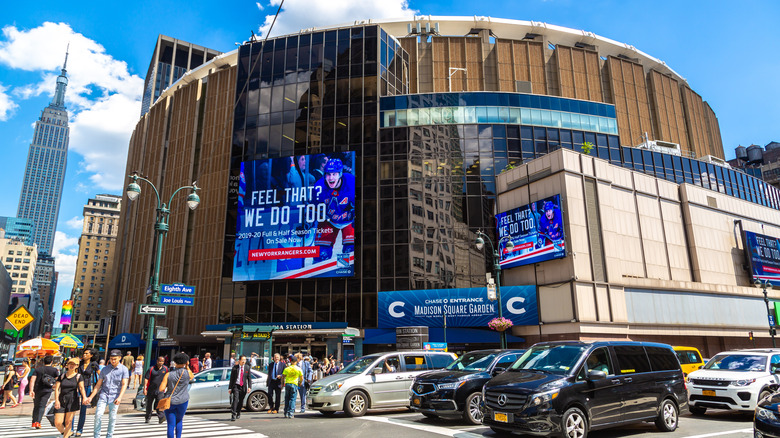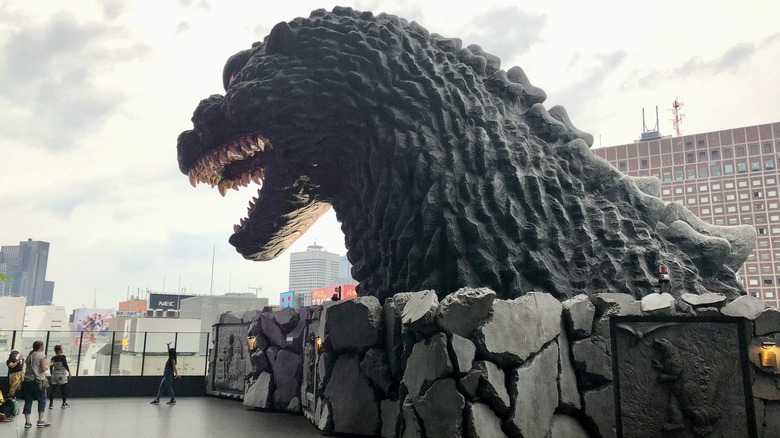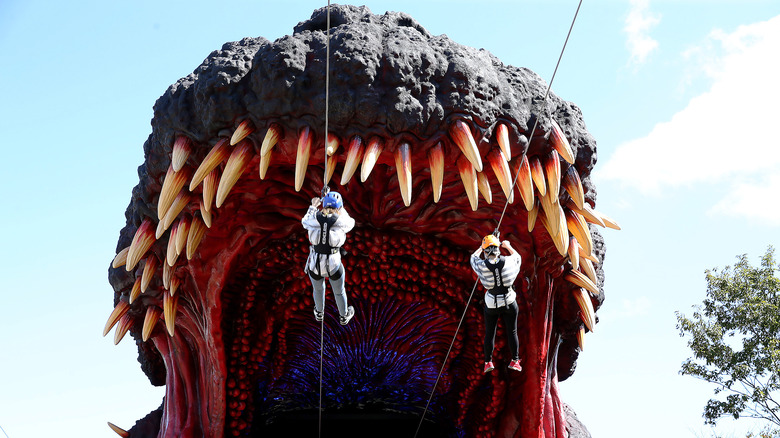Where To Find The Real-Life Landmarks Demolished By Godzilla Onscreen
In addition to being a pop culture icon known the world over, Godzilla can provide some truly outsized travel inspiration. With five American movies and a whopping 32 produced by Toho Studios in Japan, Guinness World Records recognizes "Godzilla" as the longest continuously running movie franchise out there. That means the King of Monsters has had decades to do what he does best and attack cities or fight other giant monsters across them. This has led to the fictional destruction of many famous landmarks. Yet in the real world, you'll often find those landmarks still standing in Tokyo and other cities in Japan — and even a few abroad in cities like Hong Kong, New York, and San Francisco.
If you're the type of moviegoer who also enjoys venturing out of the theater and into the city on your travels, you'll want to check out some of these real-life locations that Godzilla has menaced on film.
Tokyo landmarks
Tokyo seems like a natural starting point, since it's the first big city the King of Monsters ever attacked back in the original "Godzilla" movie in 1954. Over the years, he's continued to wreak havoc on Japan's capital more than any other city. A symbol of the Ginza shopping district, the Seiko House Ginza Clock Tower on top of the Wako department store building was one of the first major Tokyo landmarks to meet Godzilla's fiery movie wrath. As if to say, "You know what time it is," Godzilla rips the clock right off the building just as it chimes 11. In real life, you can still find it keeping time at the same intersection.
Not far from there is the National Diet Building, which you can tour in English to this day. Onscreen, Godzilla '54 spares the government building's central tower but stomps through the House of Representatives on his way to the Kachidoki Bridge. This is one of the many bridges you'll see if you stroll along the Sumida River (you can also take a water bus ride down it). Both landmarks are visible in different open-top Sky Bus tours of the city.
Godzilla has returned to Tokyo many times, fighting his three-headed archenemy, for example, outside the Tokyo Metropolitan Government Building in "Godzilla vs. King Ghidorah." Nicknamed "Tocho," the building has two free 45th-floor observatories in its twin towers. In the 2016 live-action Japanese film "Shin Godzilla," the King of Monsters ends his rampage outside Tokyo Station. A sculpture of him with the movie's shooting script in it is located nearby in Hibiya Godzilla Square. You can see an older statue of him — based on his look in "Godzilla vs. Destroyah" — in the lobby of Toho Cinemas Hibiya.
Osaka, Atami, Nagoya, Yokohama, and Kyoto landmarks
Outside Tokyo, Godzilla has a knack for destroying Japanese castles, beginning with his very first sequel, "Godzilla Raids Again," in 1956. That's where Osaka Castle — as much an enduring emblem as Osaka Aquarium Kaiyukan — becomes collateral damage in Godzilla's battle with the monster Anguirus.
Save for the American re-edit of the original, next in line was 1962's "King Kong vs. Godzilla," where Atami Castle fares no better. That castle and Osaka's were built and rebuilt — respectively — just decades ago, and they both sport modern trappings, such as an erotic ukiyo-e gallery and an elevator on the side of the building. Atami itself is a major hot spring destination, and its castle is really a museum constructed to look like a castle (on a mountaintop where no such castle ever existed).
Nagoya Castle, by contrast, is a reconstruction of an original structure dating back hundreds of years. In 2024, its main keep is set to be torn down and reconstructed again to make it more earthquake-resistant. It seems life imitates art since Godzilla already tore down the castle after he tripped and fell into it 60 years earlier in "Mothra vs. Godzilla" in 1964.
Japan has almost as many Ferris wheels as castles, one example being Yokohama's Cosmo Clock 21. It's toppled along with Yokohama Landmark Tower (one of the country's tallest buildings) in "Godzilla vs. Mothra." Meanwhile, Kyoto's many beautiful temples and shrines find cinematic representation with Kiyomizu-dera, a landmark that Godzilla lumbers past (but doesn't destroy) in "Godzilla vs. Mechagodzilla 2."
Hong Kong, New York, and San Francisco landmarks
Like the globe-trotting spy James Bond, Godzilla's adventures are a travelogue that isn't limited to one country. Outside Japan, his 2021 live-action appearance in "Godzilla vs. Kong" saw him wading through Victoria Harbour into Hong Kong, where he had an epic throwdown with King Kong and Mechagodzilla against the backdrop of skyscrapers including the Bank of China Tower.
It wasn't the first time Godzilla visited Hong Kong. That would be "Godzilla vs. Destroyah," when he bore down on the city's Jumbo Floating Restaurant. Unfortunately, despite also appearing in Bruce Lee and Jackie Chan films, that's one real-life landmark that has gone the way of the numerous boats Godzilla has sunk onscreen. In 2022, the floating restaurant capsized while being towed out to sea.
In "Destroy All Monsters," Godzilla assaults the United Nations in New York. The 1998 American "Godzilla" film has the King of the Monsters lay eggs in Madison Square Garden, a well-known concert and sports venue, home of the New York Knicks and New York Rangers. In the movie's climax, Godzilla gets tangled in the cables of the Brooklyn Bridge, which you can walk across or admire from spots like Pier 17.
Though it's set in San Francisco, the 2014 American "Godzilla" film was shot in Vancouver. Yet it recreates the iconic Golden Gate Bridge (before Godzilla plows through it), and during the HALO jump scene, you can see other famous landmarks of the city's skyline like the Transamerica Pyramid.
The Godzilla head and room at Hotel Gracery Shinjuku
Travelers need nightly shelter, and one thing we haven't talked about yet is where you might be seeking it in your Godzilla-themed travels. Fortunately, Godzilla doesn't just destroy landmarks — he himself has become one in Kabukicho, a popular entertainment district in Shinjuku, Tokyo. There's even a "Godzilla Road" here, where you'll see his 80-ton head peeking over the 8th-floor terrace of the Shinjuku Toho Building. That floor is where the Hotel Gracery Shinjuku's lobby is located. While not the cheapest room available, the hotel has a special Godzilla Room where you can sleep under the monster's claw and enjoy a gallery of movie posters on the wall. Even if you go for one of Tokyo's other unique hotels, you can still see the life-sized Godzilla head by hitting up the Cafe Terrace Bonjour, then stepping out on the adjacent terrace. The head matches the monster's look from "Godzilla vs. Mothra."
Diehard Godzilla fans can make the pilgrimage to Toho Studios in Setagaya, Tokyo, where a huge mural and another statue of the King of the Monsters decorate the entrance. Across town in Koto at the Daigo Fukuryu-Maru Exhibition Hall, you'll find Lucky Dragon No. 5 — the real-life fishing boat irradiated by a U.S. hydrogen bomb test that inspired the opening scene in the first "Godzilla" film.
The Godzilla Interception Operation Awaji attraction
The full-body Godzilla statue in Hibiya Godzilla Square is the biggest one of its kind in Japan, and for a while, after it debuted, you could get right up behind it and have its larger-than-life tail in your face. At present, there's a cafe operating behind the statue, so alas, most passers-by will just be looking up at it on its pedestal. It seems smaller and less domineering from afar, but that's not a problem for the creature's humongous head at Godzilla Interception Operation.
Part of the Nijigen no Mori theme park on Awaji Island (accessible from Kobe via the Akashi-Kaikyo Bridge), Godzilla Interception Operation is an attraction that lets you zip-line into the open mouth of another life-sized King of Monsters. The sight of Godzilla's gaping maw is quite impressive, even more so when you're headed straight into it.
Like the Hibiya statue, this version of Godzilla is modeled on his appearance in "Shin Godzilla." However, that's not all Nijigen no Mori has to offer in the way of Godzilla experiences. The park is also home to the world's first permanent Godzilla museum, where you can see exhibits of the monster looming over Tokyo Station and fighting Mechagodzilla with Mothra, as seen in the film "Godzilla: Tokyo S.O.S."
